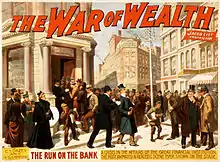1893年恐慌
1893年恐慌是美国一次严重的经济萧条,始于1893年,[1]於1897年結束。
| 年份 | Lebergott | Romer |
|---|---|---|
| 1890 | 4.0 | 4.0 |
| 1891 | 5.4 | 4.8 |
| 1892 | 3.0 | 3.7 |
| 1893 | 11.7 | 8.1 |
| 1894 | 18.4 | 12.3 |
| 1895 | 13.7 | 11.1 |
| 1896 | 14.5 | 12.0 |
| 1897 | 14.5 | 12.4 |
| 1898 | 12.4 | 11.6 |
| 1899 | 6.5 | 8.7 |
| 1900 | 5.0 | 5.0 |

原因
1893年恐慌的原因之一可以追溯到阿根廷。巴林兄弟银行的阿根廷代理行在阿根廷进行了大笔投资。然而布宜诺斯艾利斯政变使投资无法持续。由于欧洲投资者担心这些问题可能扩散,他们开始向美国财政部挤兑黄金,因为对他们而言将美元投资兑换成可出口的黄金相对容易。[2] 在19世纪七八十年代的镀金时代,美国经历了经济增长和扩张,但大部分扩张依赖高昂的国际大宗商品价格,然而1893年小麦价格暴跌。[3]
问题的第一个明显迹象出现在1893年2月20日,[4] 格罗弗·克利夫兰总统就职典礼前13天。当天费城和雷丁铁路公司的破产接管人得到任命,该公司曾经极大地过度扩张。[5] 上任后,克利夫兰与财政部直接处理危机,[6] 并成功说服国会废除谢尔曼白银采购法案,克利夫兰认为该法案要对这场经济危机负主要责任。[7]
随着对国家经济状况的担忧加剧,人们争相从银行提取存款,造成银行挤兑。信贷紧缩波及整个经济。英国金融恐慌和欧洲贸易下滑导致外国投资者抛售美国股票,以获得以黄金支撑的美国资金。[8]
白银
自由银币运动兴起,获得了农民的支持(试图刺激经济,引发通货膨胀,从而能够用更廉价的美元偿还债务) 和矿业利益集团(争取将白银纳入货币的权利)。1890年的谢尔曼白银采购法案并未达成自由银币运动的目标,该法案要求美国政府购买数百万盎司的白银,这已超出1878年布兰德-艾利森法案(该法案抬高银价以取悦银矿矿主)的要求。人们试图用白银券赎回黄金。最终美联储的黄金储量达到最低法定限额,美国货币不再能兑换黄金。[8] 这段恐慌时期的投资活动主要通过高利息债券融资。市场传言全国绳索公司(当时交易最活跃股票)陷入财务困境,导致银行家要求该公司偿还贷款,企业因此进入破产管理阶段。这家绳索制造公司曾试图垄断全国进口麻市场。随着白银需求和白银券价值下降,白银价格和价值猛跌。债券持有者忧虑债券面值损失,其中很多已经一文不值。
一系列银行倒闭接踵而至,北太平洋铁路、联合太平洋铁路和艾奇逊·托皮卡和圣菲铁路公司破产。随之而来的是许多其他公司破产;超过15,000家企业和500家银行破产,其中多数在西部。根据较高的估计,在恐慌最严重时约17%-19%的劳动力失业。失业急剧飙升,加上由于银行破产导致的生活储蓄损失,意味着一度安全的中产阶层无法再偿还房屋抵押贷款。结果许多人失去了自己建成伊始的住宅。[10]
影响

这场恐慌导致股价下跌。500家银行关闭,15000家企业破产,众多农场停止运营。失业率在宾夕法尼亚州达到25%,在纽约为35%,在密歇根州是43%。施粥所开放以接济赤贫者。面对饥饿人们砍柴、破岩、缝纫以换取食物。在一些情况下妇女靠卖淫养活家庭。为了救助底特律的民众,市长黑曾·平格利开设了“平格利土豆地”,一种社区农业园。[11]
1890年谢尔曼白银采购法案,可能也包括同年的贸易保护主义麦金莱关税,已被认为是恐慌的部分成因。因为该法案应西部银矿所有者的要求而通过,这些矿主已经过度生产了白银,而法案要求美国财政部用白银或黄金支持的纸币购入白银。民主党人和总统克利夫兰因为萧条备受指责。国库黄金储备也下降至危险水平。这迫使克利夫兰总统向华尔街银行家J.P.摩根和英格兰罗斯柴尔德家族[12]借入价值6500万美元的黄金以支持金本位制。[13] 在随后的1894年大选中民主党和人民党惨败。这次选举是共和党有史以来的最大胜利。[14]
参见
- 丹佛1893年萧条
参考文献
- Timberlake, Jr., Richard H. . Glasner, David; Cooley, Thomas F. (编). . New York: Garland Publishing. 1997: 516–18. ISBN 0-8240-0944-4.
- Nelson, Scott Reynolds. 2012. A Nation of Deadbeats. New York: Alfred Knopf, p. 188.
- Nelson, Scott Reynolds. 2012. A Nation of Deadbeats. New York: Alfred Knopf, p. 189.
- . Findlaw. [2016-06-29]. (原始内容存档于2012-11-05).
- James L. Holton, The Reading Railroad: History of a Coal Age Empire, Vol. I: The Nineteenth Century, pp. 323–325, citing Vincent Corasso, The Morgans.
- "Grover Cleveland (页面存档备份,存于)," whitehouse.gov
- "Grover Cleveland (页面存档备份,存于)," American President: A Reference Resource, millercenter.org
- Whitten, David O. . eh.net. [2009-04-20]. (原始内容存档于2009-04-27).
- Hasia R. Diner. . U. of California Press. 2004: 170 [2016-06-29]. (原始内容存档于2020-01-02).
- Hoffman, Charles. The Depression of the Nineties: An Economic History. Westport, CT: Greenwood Publishing, 1970. p. 109.
- Parshall, Gerald. "The Great Panic Of '93." U.S. News & World Report 113.17 (1992): 70. Academic Search Complete. Web. 26 Feb. 2013.
- . [2016-06-29]. (原始内容存档于2017-02-07).
- . [2016-06-29]. (原始内容存档于2020-11-09).
- Frail, T. A. "Top 10 Historic Midterm Elections (页面存档备份,存于)." Smithsonian.com, Oct. 14, 2010.
扩展阅读
当代来源
- American Annual Cyclopedia...1894 (1895) online(页面存档备份,存于)
- Baum, Lyman Frank and W. W. Denslow. The Wonderful Wizard of Oz (1900); see Political interpretations of The Wonderful Wizard of Oz
- Brice, Lloyd Stephens, and James J. Wait. “The Railway Problem.” North American Review 164 (March 1897): 327–48. online at MOA Cornell.
- Cleveland, Frederick A. "The Final Report of the Monetary Commission," Annals of the American Academy of Political and Social Science 13 (January 1899): 31–56 in JSTOR(页面存档备份,存于)
- Closson, Carlos C. Jr. "The Unemployed in American Cities." Quarterly Journal of Economics, vol. 8, no. 2 (January 1894) 168–217 in JSTOR)(页面存档备份,存于); vol. 8, no. 4 (July 1894): 443–477 in JSTOR(页面存档备份,存于)
- Fisher, Willard. "‘Coin’ and His Critics." Quarterly Journal of Economics 10 (January 1896): 187–208 in JSTOR(页面存档备份,存于)
- Harvey, William H. Coin’s Financial School (1894), 1963 (Introduction by Richard Hofstadter). online first edition(页面存档备份,存于)
- Noyes, Alexander Dana. "The Banks and the Panic," Political Science Quarterly 9 (March 1894): 12–28 in JSTOR(页面存档备份,存于).
- Shaw, Albert. "Relief for the Unemployed in American Cities," Review of Reviews 9 (January and February 1894): 29–37, 179–91.
- Stevens, Albert Clark. "An Analysis of the Phenomena of the Panic in the United States in 1893," Quarterly Journal of Economics 8 (January 1894): 117–48 in JSTOR(页面存档备份,存于).
次要来源
- Barnes, James A. John G. Carlisle: Financial Statesman (1931).
- Barnes, James A. . Mississippi Valley Historical Review (The Mississippi Valley Historical Review, Vol. 34, No. 3). 1947, 34 (3): 383–394. JSTOR 1898096. doi:10.2307/1898096.
- Destler, Chester McArthur. American Radicalism, 1865–1901 (1966).
- Dewey, Davis Rich. Financial History of the United States (1903). online(页面存档备份,存于).
- Dighe, Ranjit S. ed. The Historian's Wizard of Oz: Reading L. Frank Baum's Classic as a Political and Monetary Allegory (2002).
- Dorfman, Joseph Harry. The Economic Mind in American Civilization. (1949). vol 3.
- Faulkner, Harold Underwood. Politics, Reform, and Expansion, 1890–1900. (1959).
- Feder, Leah Hanna. Unemployment Relief in Periods of Depression ... 1857–1920 (1926).
- Friedman, Milton, and Anna Jacobson Schwartz. A Monetary History of the United States, 1867–1960 (1963).
- Harpine, William D. From the Front Porch to the Front Page: McKinley and Bryan in the 1896 Presidential Campaign (2006) excerpt and text search (页面存档备份,存于)
- Hoffmann, Charles. . Journal of Economic History. 1956, 16 (2): 137–164. JSTOR 2114113.
- Hoffmann, Charles. The Depression of the Nineties: An Economic History (1970).
- Jensen, Richard. The Winning of the Midwest: 1888–1896 (1971).
- Josephson, Matthew. The Robber Barons New York: Harcourt Brace Jovanovich (1990).
- Kirkland, Edward Chase. Industry Comes of Age, 1860–1897 (1961).
- Lauck, William Jett. jays journal The Causes of the Panic of 1893 (1907). online(页面存档备份,存于)
- Lindsey, Almont. The Pullman Strike 1942.
- Littlefield, Henry M. . American Quarterly (American Quarterly, Vol. 16, No. 1). 1964, 16 (1): 47–58. JSTOR 2710826. doi:10.2307/2710826.
- Nevins, Allan. Grover Cleveland: A Study in Courage. 1932, Pulitzer Prize.
- Rezneck, Samuel S. . Journal of Political Economy (The Journal of Political Economy, Vol. 61, No. 4). 1953, 61 (4): 324–345. JSTOR 1826883. doi:10.1086/257393.
- Ritter, Gretchen. Goldbugs and Greenbacks: The Anti-Monopoly Tradition and the Politics of Finance in America (1997)
- Ritter, Gretchen. . Journal of American Studies. 1997, 31 (2): 171–203. doi:10.1017/S0021875897005628.
- Rockoff, Hugh. . Journal of Political Economy (The Journal of Political Economy, Vol. 98, No. 4). 1990, 98 (4): 739–760. JSTOR 2937766. doi:10.1086/261704.
- Romer, Christina. . Journal of Political Economy. 1986, 94 (1): 1–37. doi:10.1086/261361.
- Schwantes, Carlos A. Coxey’s Army: An American Odyssey (1985).
- Shannon, Fred Albert. The Farmer’s Last Frontier: Agriculture, 1860–1897 (1945).
- Steeples, Douglas, and David O. Whitten. Democracy in Desperation: The Depression of 1893 (1998).
- White; Gerald T. The United States and the Problem of Recovery after 1893 (1982).
- Whitten, David. EH.NET article on the Depression of 1893(页面存档备份,存于)
- Wicker, Elmus. Banking panics of the gilded age (Cambridge University Press, 2006) contents
外部链接
- Causes of the Business Depression by Henry George; appeared in Once a Week, a New York periodical, March 6, 1894